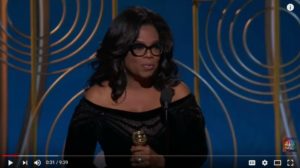I was blown away by Oprah’s Golden Globes speech. Although it clocked in at just under 10 minutes, it was incredibly rich in meaning and beautifully delivered.
So I thought I’d take this opportunity to explain to my subscribers the specific rhetorical devices and tools Oprah included that made it one of the very best, most eloquent speeches I have heard in a long time. By deconstructing and analyzing it for you, my hope is you will see how it’s done as you work on becoming a more polished and confident speaker and presenter.
Watch Oprah’s speech below:

Go to this link to have a transcript of the speech in front of you as you read through my comments.
First Paragraph:
- After the opening thank yous, the first line begins a story. “In 1964 I was a little girl…” ALWAYS start your speeches with a story. This one was about Sydney Poitier being the first black person to accept an Oscar. Note how she paints a picture, Ann Bancroft opening the envelope and making the announcement, the color of Poitier’s tie — and the color of his skin.
- That line, the white tie juxtaposed against the black skin is a rhetorical device known as opposition.
- “As a kid watching from the cheap seats as my mom came through the door bone tired from cleaning other people’s houses…” quickly fills us in on Oprah’s working-class or more likely, lower-class childhood.
- She describes how it felt in a way we can also feel and what it meant to her.
- She goes on to compare Poitier’s acceptance of the same award she has just received.
- She concludes the paragraph with a reference to how other little girls may be feeling watching her accept this award. This ties back to the opening line.
- This entire paragraph story is a setup for what comes next.
Second Paragraph:
- In the opening sentence, she states it is a privilege to share it with those same little girls, including a group most people would leave out. This shows affection and empathy.
- The repetition of the word “who’ve” as she tells us how she came to be on this stage is a device known as anaphora. This is a mesmerizing device and is usually presented in groups of 3, though Oprah’s groups are longer and she uses the device several times.
- The list of names of people who’ve helped her is another rhetorical device known as asyndeton, which is also repetitive, but without using the same opening words.
- Then, she makes a strong point about the value of the press. The Golden Globes is a press association, so this is not lost on them or anyone else in the room.
Third Paragraph:
- The primary point is then made about speaking one’s truth, which she ties to the job of the press and by emphasizing how inspired she has been by women who’ve come forward to report abuse and harassment. Here, too, she expands the group to include the powerless.
Fourth Paragraph:
- This first line is extraordinary because she expands the concept of speaking truth by doing just that and lightening the load of women who had “children to feed, bills to pay, and dreams to pursue…” She seems to be saying she does not judge them and they should not feel any guilt for doing what was necessary at the time.
- The rest of the paragraph lists a variety of fields and she once again uses anaphora, starting each phrase with the word, they’re.
Fifth Paragraph:
- She tells the story of Recy Taylor, a name most haven’t heard, and makes a historical connection to Rosa Parks, a name most of us have heard. She dramatizes Parks’s story by implying the Recy Taylor incident must have played a part in her decision to stay seated on that bus in Montgomery. We don’t know if this is true, but it feels true. This is the overarching story’s culmination.
- She fills us in on why she has made the professional choices she has made, all having to do with how we suffer and eventually, overcome. She also once again uses anaphora, this time with the word, how.
- “Hope for a brighter morning — even during our darkest nights” is a strong metaphor that also uses opposition, so a combination of rhetorical devices.
Sixth Paragraph:
- The climax begins here with an immediate tieback to the little girls of the opening paragraph. This is what we call a bookend, which is a story that ties back to the opening story (or an earlier story).
- “New day finally dawns” completes the preceding metaphor.
- Oprah concludes with a strong shout-out to the “me too” movement.
This was an overarching narrative about truth, particularly speaking truth to power, beginning in the early days of the civil rights movement, and continuing through the present day. It has an almost poetic level of rhythm. It was a serious speech, delivered with empathy. Note there was nothing funny. It was a classic morality tale, delivered from the heart, intended to take full advantage of the platform.
Of course, Oprah also delivered it beautifully. She made it look easy, but it was so well-rehearsed. She knew where her voice was going to rise and fall, she understood where to pause, where the applause lines might be. Her pacing and timing was perfect. And don’t discount the probability that the adrenaline was flowing, both through her and through her audience.
We must also not forget Oprah is a trained performer, with decades of experience. But make no mistake; this speech took a lot of work.
I must also point out that speaking of this quality is extraordinarily rare. It’s a game-changer. Although Oprah is already quite famous, this performance opens new doors.
And that is how it’s done.

